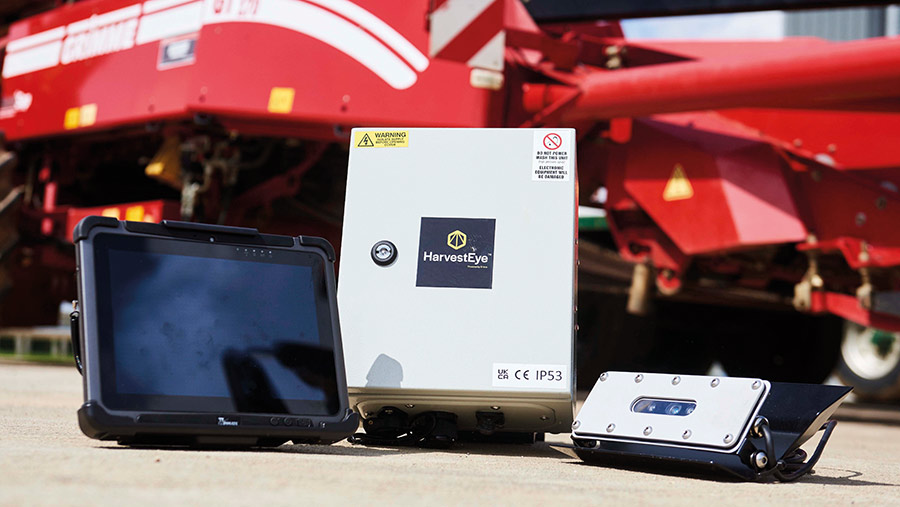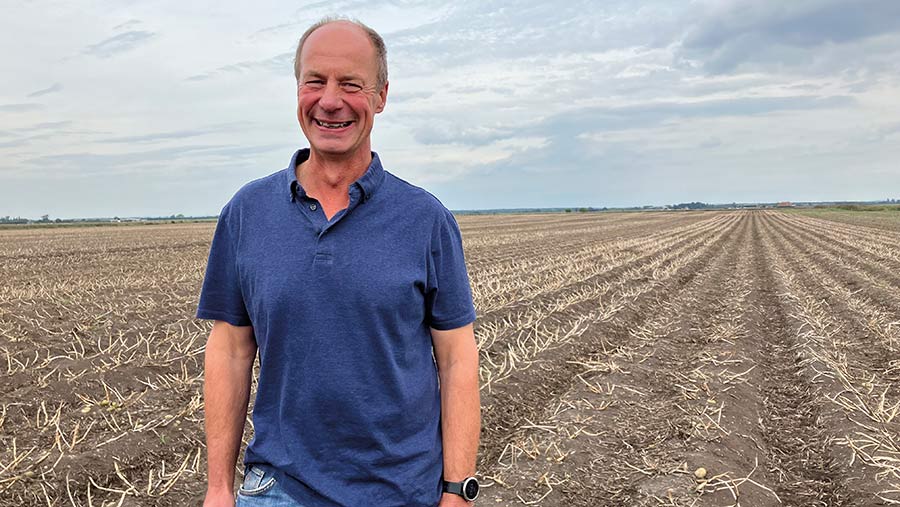Video: Camera technology improves marketability for potato growers
 © B-Hive Innovations
© B-Hive Innovations Kitted out with a camera, GPS system and a portable tablet, Harvest Eye technology is helping potato growers improve marketability by sizing and counting crops.
A unique camera system which measures the size and count of root crops is providing growers with valuable information on their precise size profile to improve marketability.
See also: Direct potato sales help grower overcome rise in costs
The technology, known as Harvest Eye, is an innovative system which fits to existing harvesting equipment or grading lines for both potato and onion crops.
Using patented technology and machine learning, the device provides live information on the performance of whole fields.
Crop variability can also be mapped across individual field locations, providing targeted agronomic performance data.
How Harvest Eye works
Harvest Eye sales account manager Ed Strawson explains how the device can support decision making with detailed data sets.
“It is a very straightforward system which mounts on a harvester or grader. It can sense the difference between the potato, clod or a stone, giving accurate sizing and count information for the crop.”
Kitted out with a camera, GPS technology, and a tablet inside the cab, information is remotely sent to a data portal, with reports displayed in easy-to-read bar graphs.
Data is also displayed via GPS field maps which demonstrate where specific potato sizes are located.
Together, these insights help growers to better plan stocks to customers to ensure fresh produce meets quality expectations.
We speak to two potato growers who are using the Harvest Eye technology to find out more about its benefits.
Tom Stevenson, New Hall Farm, Essex
Essex potato grower Tom Stevenson grows 160ha of potatoes on mostly rented land and has successfully used the Harvest Eye system for six seasons.
Initially using the camera technology on his potato harvester back in 2016, it soon became apparent that fitting the device to the potato grader would allow him to get the most from the technology.
Using the device in this way enables him to size the crop going into store and tailor specific crop sizes to customer needs.
“The better you know your crop, the better you are able to market it. More of our crops are going to the right homes.
“Some customers may want a bigger, bolder sample while others may want a more medium-size potato.
“We know what we have and can market it accordingly – it’s all part of building the bigger picture,” he says.
Potatoes are harvested in bulk and then brought into the yard for cleaning and grading, which is why the system is more suited to the grader than the potato harvester.
Mr Stevenson is also avoiding costly size specification penalties by supplying customers with more accurate sizes.
“Harvest Eye looks at the finished product and sizes and counts the different sizes from different fields on different days. It splits the crop into 5mm size brackets.
“These categories are user defined – it does have the ability to size smaller but that is as detailed as we need to be.
“The smallest tuber size of our potatoes going into store is about 45mm while our biggest is 85mm.”
The count and size data are linked to a portal where users can delve into the data which is regularly updated.
“With 20 different potato fields and about 30 different stocks, the technology allows us to cross-reference size with specific field labels. What’s more, the markets change at different times of the year so we can fit this according to market requirements – we are really reaping the benefits of the system,” he concludes.
Harvest 2022
Mr Stevenson continues that, although yields were down 15-20% this year due to drought, there was enough moisture in the crop to avoid bruising and costly quality penalties.
“Overall, harvest 2022 went well with no major disruptions. We initially feared the dry summer would cause severe crop bruising at harvest, but fortunately our irrigation system maintained quality.
“Yields, however, were disappointing. Our crop of King Edwards would usually yield 42t/ha and the more conventional varieties such as Mozart, Laura and Picasso 55t/ha, but this was not the case.”
Irrigation is an absolute necessity for Mr Stevenson, whose family has farmed at New Hall Farm since 1902.
All potato crops are irrigated using 273m litres of water, but this was not sufficient this season due to the severe lack of rain.
“We were flat-out irrigating from late May to August with no natural rain shower break.
“We would usually use a rate of 5in of irrigation water per acre, but this year we were applying 8in and in some places more.”
Harvest started on 24 August and ran for about a month. Crops are destined for long-term storage for the supermarket trade and some for export to the Canary Islands.
David Armstrong, Abbey Farm, Lincolnshire

© MAG, Emma Gillbard
One early trial user of the technology is Lincolnshire grower David Armstrong, who is working closely with potato supplier Branston to develop the device and provide farmer feedback.
He has used the setup on his potato harvester for four seasons, and over recent years is making the most from auto-generated harvest reports sent via email from the portal, providing insights on varieties and field performance.
“The size and count of tubers is linked to GPS yield mapping, where we are finding higher yields and greater sized tubers on the heavier clay soils as a result of greater moisture retention. However, quality can sometimes be poorer as damper soils create more cloddy seedbeds which mean air pockets can form, leading to a poorer skin finish and scab issues.”
At present, potato sizing is based on small samples which often fail to account for the variability across fields according to soil type, pests and disease, which can make marketing crops a challenge.
He sees the device as particularly beneficial for potato farmers growing for the seed market, and for those without a potato contract, as it will enable them to know exactly what crops they have in store and help them market them better.
The technology also has massive benefits for end-users. There may even be the opportunity in the future to charge a premium for crops as you know exactly what your size stocks are, as this saves the processor money, he says.
What does it cost?
For a typical 10,000t potato farmer the annual insight is about 75p/t. Various commercial models are available to suit individual farmers, grower groups and packers.
These include lease, hire and purchase, where demonstrations can also be arranged.
Looking ahead, the company plans to expand its technology for use in other root crops.

